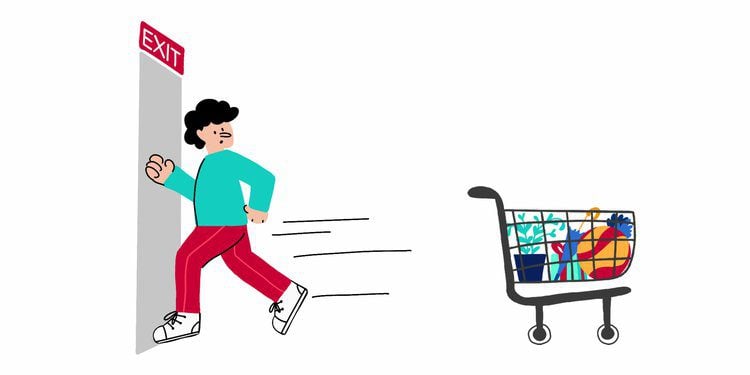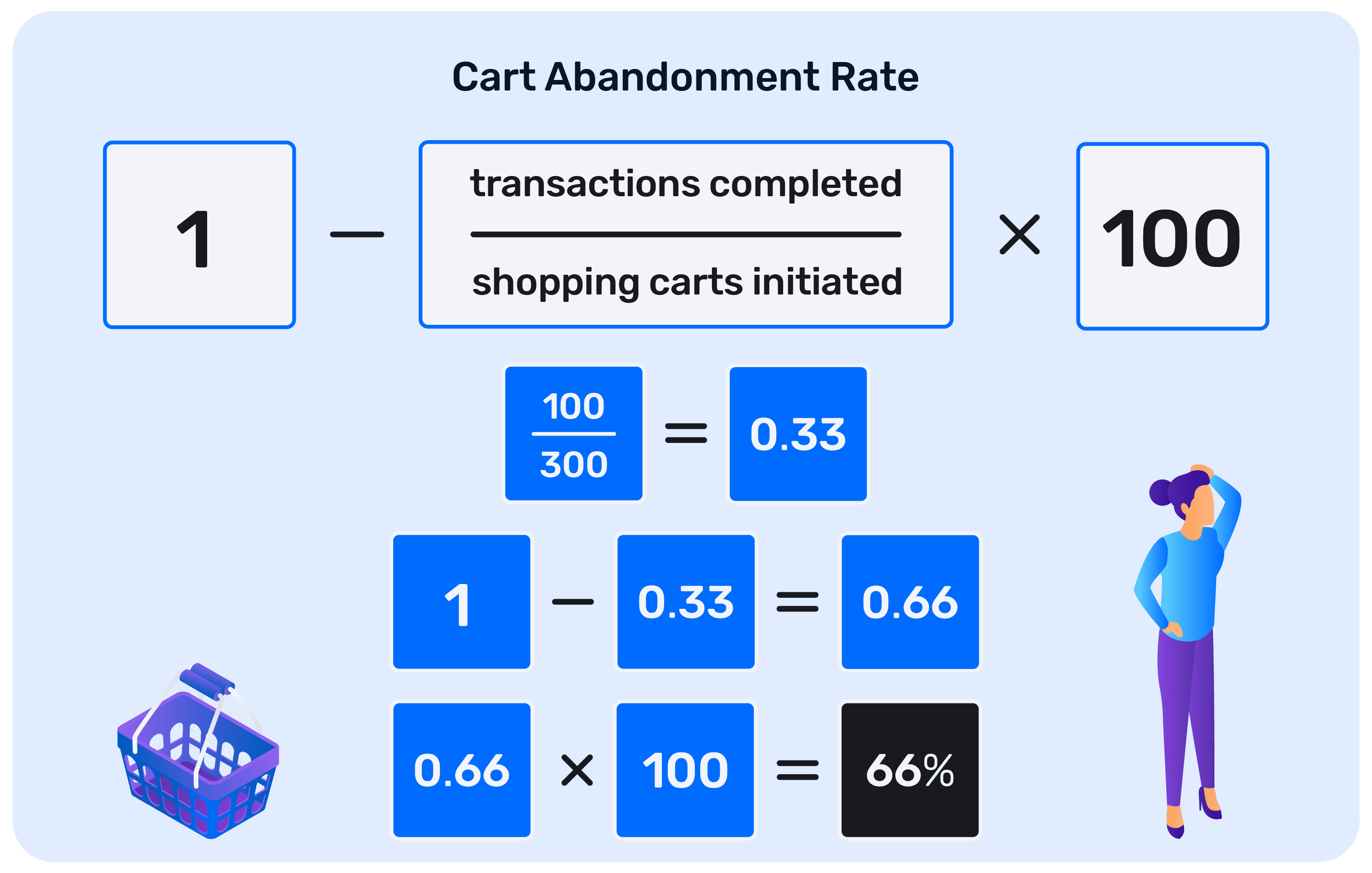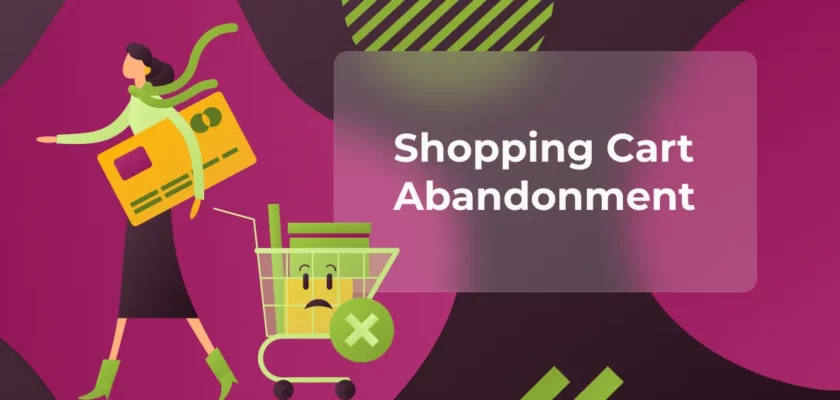Table of Contents
- 1 What Is the Average Cart Abandonment Rate?
- 2 Top Reasons for Abandoned Carts on Amazon
- 3 Top Reasons for Abandoned Carts on Amazon
- 4 Why Is Shopping Cart Abandonment a Problem for Amazon Sellers?
- 5 Cart Abandonment Analysis: 6 Effects beyond Loss of Profits
- 6 How to Calculate Cart Abandonment Rate?
- 7 Which Shopping Cart Abandonment Rate Is Normal?
- 8 How to Reduce Cart Abandonment?
- 9 How to Integrate Marketing Tactics in Cart Abandonment Solutions?
- 10 How to Decrease Shopping Cart Abandonment Rate by Optimizing Your E-commerce Store?
- 11 Сonclusion: Reducing Cart Abandonment
Why is shopping cart abandonment a problem for retailers?
We all love online shopping because of the convenience it promises. But the harsh realities of e-commerce sellers aren’t so sunny – nearly 80% of all shopping carts created are abandoned and forgotten. Unfortunately, Amazon isn’t an exception. While the marketplace doesn’t share the official statistics on its shopping cart abandonment rate, it would be logical to assume that it is also pretty high. So let’s find out what shopping cart abandonment is, its reasons, and the best practices to reduce cart abandonment that will work for your Amazon store.
What Is the Average Cart Abandonment Rate?
Recent research conducted by Baymard Institute states the average shopping cart abandonment indicator varies by device, with tablet and mobile devices keeping the highest percentage of buyers hitting the exit button on their checkout page:
- Mobile: 86%
- Tablets: 81%
- Desktop: 70%
The location of your clients plays a crucial role in how likely they’re to abandon online shopping baskets, too. For instance, some 87% of carts in Spain are abandoned in the middle of shopping. In turn, buyers in the Netherlands maintain the lowest abandonment rate at 65%.
Certain products also have more significant drop-offs. For instance, leather items, lingerie categories, and women’s knitwear are most predisposed to “online window-shoppers.”
Unsurprisingly, December is the month when shopping cart abandonment shows the highest rates. It’s because holiday and Black sales indicate more users are shopping (thus, the growth in cart abandonment).
Many aspects influence online store cart abandonment, so it is safe to say that most individuals adding goods to their online baskets will not complete their purchase—for some reason or another. However, that does not mean you can do nothing about it. Keep reading this article to understand the main drivers of this phenomenon.
Top Reasons for Abandoned Carts on Amazon

Top Reasons for Abandoned Carts on Amazon
There are several reasons for shopping basket abandonment. Generally, their list can be longer, but when it comes to Amazon, the user behavior patterns become slightly different.
No Amazon Prime opportunities
Amazon Prime shoppers are already used to their Prime subscription’s beneficial opportunities. So, when there is a product they would like to buy but no Prime eligibility for it, the likelihood of an eCommerce abandoned cart increases. In addition, they don’t want to pay extra shipping costs, especially when the item’s price is equal or almost equal to the shipping cost or the item itself isn’t unique and desirable enough to overpay for it.
Lack of product details
eCommerce purchases are emotion-driven. Most of us add the item to the cart, guided by instant emotion. We return to the product description and turn the rational thinking on. At this point, the users may discover that they lack product information, details, pictures, or videos and decide to research them elsewhere or postpone the purchase.
Lack of trust
There are millions of sellers on Amazon, but not all of them are equally reliable and honest, even despite Amazon’s efforts to deliver the best and safest shopping experience possible. Bad or average reviews from previous buyers increase the likelihood of shopping basket abandonment. What’s more, there are few chances that the buyers will discover your store as such – Amazon tends to give more visibility to the stores with as high product ratings as possible.
Pricing issues
The opportunity to shop at the best prices is one of the benefits Amazon shoppers appreciate. And honestly, most of them are never sure the price they pay is the best. They can abandon a cart because of the intuitive feeling that there can be a better offer somewhere.
Abundance of choice
This reason for shopping basket abandonment is highly relevant for Amazon. The more options your users have, the fewer chances are for making the final decision. The only exception is purchasing from proven sellers and buying a product they know well and need daily. What’s more, you can do nothing for this reason since the ultimate goal of Amazon is to provide users with the best choice options at the best prices and with the best shopping experience.
Window shopping
Finally, the last point in shopping cart abandonment is just window shopping. It is when the users just add desired items to the cart, creating an artificial feeling of purchase and one-minute satisfaction from it, and then – just abandon the cart. It is a widespread behavior of modern shoppers, allowing them to browse the offers, select the items they like, and leave them, thereby saving their budget.
What’s more, when it comes to an ordinary eCommerce store, the reasons for shopping cart abandonment can go on and on.
- The users may don’t want to create an account, but the system requires them to do it, plus they share too much information;
- The checkout experience may seem to the users too long or unsafe;
- There can be no multiple payment options;
- The product pages load times are too slow;
- The website’s design may be so frustrating that finding the “Add to Cart” button becomes impossible.
Why Is Shopping Cart Abandonment a Problem for Amazon Sellers?

What is shopping cart abandonment? Shopping cart abandonment stands for the situation when the users add to the cart but do not check out. Initially driven by the intention to buy something, the buyers just interrupt the shopping process one step away from finalizing the deal.
The average checkout abandonment rate is nearly 80%, and it can even reach 96,8% for some industries – for example, automotive and childcare niches, according to Statista. Indeed, this situation is disappointing for sellers regardless of their business specifics.
Why is shopping cart abandonment a problem for retailers? The reason is pretty apparent – when the users add items to their cart but aren’t completing a purchase, it means a loss of sales, profits, and, in some cases, prospective customers. But the damaging effects of shopping cart abandonment don’t end with losing an opportunity to sell an item.
The more shopping carts are abandoned, the lower your conversion rate is since it is calculated as the relation between the total number of visitors and those purchased. In some cases, the consequences of basket abandonment during online shopping have a reputational background that’s pretty challenging to restore.
Cart Abandonment Analysis: 6 Effects beyond Loss of Profits
Let’s delve deeper into the damaging effects of shopping cart abandonment. It leads to losses worth billions of dollars per year. Some clients might leave since they are just surfing the web or want to see the final price, with no intention of purchasing. Unfortunately, there is not so much that sellers can do about these lost sales other than retargeting shoppers and trying to develop a relationship over time.
Nonetheless, you can try something with another type of abandonment- those sales lost to rising shipping costs, a cumbersome checkout procedure, or failing to comprehend and personalize the experience around the client’s intent.
Losing such clients can greatly influence your profits, but total cart abandonment costs exceed lost sales. So, let’s look at top cart abandonment results beyond the revenue loss and check how merchants can save such sales.
#1. Lost client lifetime value
Customer lifetime values calculate the profit margins your brand may earn from a client during the purchase relationship.
It is crucial for digital commerce shops as it helps merchants understand the actual financial effect of advertising campaigns, boosts strategies concentrated on high-value clients and makes it simple to balance long- and short-term business goals.
Shoppers that end up with cart abandonment during online shopping are usually worth much more than their first purchase – sellers should also consider how much such clients may spend over a few years and how many other clients they may lead to your store.
From the long-term perspective, losing a potential client can cost merchants thousands of dollars due to the decreased customer lifetime value.
Getting back just one basket can bring you thousands that exceed the amount of an average customer order value.
How to solve the issue: Two platforms exist for addressing such a problem: lowering the abandoned cart rate before your client leaves and retrieving carts that customers have already abandoned.
The most efficient strategy for lowering the number of abandoned go-carts is to spot shoppers who leave their shopping carts and give them some minimal promo offer they would convert depending on their intention.
The easiest way to get back abandoned baskets is to send a cart abandonment email, which delivers customers a notification reminding them of the checkout. In addition, a minor discount or similar goods recommendation might help all those clients make the final decision. Finally, you can ask for their phone number to provide better assistance and answer the questions.
#2. Higher client acquisition costs
Many eCommerce teams spare a great share of their advertising budgets on brand awareness and obtaining new clients via paid acquisition, content marketing, influencer marketing, and social media channels.
What is the problem? If an advertising campaign or creative content brings clicks, it doesn’t mean they are driving sales. You have wasted your money on content marketing, advertisements, and lead generation when clients get through your funnel but do not convert.
Or even worse, you may not understand you are wasting the budget. For instance, an ad may drive significant amounts of clicks and impressions. It is a great advertisement (you suppose), so you continue dumping cash into it.
You do not realize that such clients are not finishing their purchase process–you lose them to shopping basket abandonment and get higher acquisition costs. Returning such lost conversions may enhance your acquisition rates and deliver more accurate information about promo efficiency.
How to solve the issue: To keep clients’ carts from influencing your acquisition expenses, ensure your checkout procedure is as convenient as possible, and provide many payment options to prevent potential clients from abandoning the carts.
#3. Inventory availability & management issues
In 2020, TikTok users crowded the website of then-President Donald Trump.
Their objective was not to buy products but to increase inventory costs by thousands of dollars by adding items to carts and then abandoning them before the checkout.
Consequently, such carts kept many items that the merchant could not sell to other clients, effectively occupying the inventory just like you may expect with physical shopping carts.
Product unavailability becomes a critical issue for online shops leading to lost transactions when real clients (ready to purchase) can’t buy their desired goods.
It is also troublesome for some travel platforms, which may have a specific number of seats or rooms available. When clients add a product to their shopping cart and do not check out, clients that would convert get a notification that goods are unavailable or out of stock.
How to solve the issue: Decreasing cart abandonment is not only about returning shopping carts and conversions. It also implies stopping before it begins by clarifying your shipping costs, including a “wishlist” option so shoppers can save products later, and displaying payment possibilities upfront. Otherwise, as in that TikTok case, you risk getting fake traffic and major problems.
#4. Distorted website statistics
As mentioned above, not all website traffic is good. Bots can lead to significant issues, especially regarding basket abandonment on Amazon. For instance, bots may load shopping carts with products they never wanted to buy during the biggest sale periods, influencing goods availability during the hottest season.
However, it does not stop there.
Abandoned carts might distort every statistic in the analytics dashboard. How come? For instance, visitors or bots that don’t convert may spend a good amount of time on your particular page. As a result, you will suppose that this page is important to the visitors. Otherwise, they may leave similar listings, making you suppose some issues are on the details page.
How to solve the issue: Think of employing bot detection tools that block fake traffic from your website and prevent distorted data.
#5. Decreased click-through-rates
Let’s face the truth. It is not impossible to reach a 0% cart abandonment rate on Amazon.
Some online customers might be surfing the platform with no intent to purchase. Others just collect information and have not achieved the proper funnel stage yet.
The thing is, such abandoned shopping carts might mess with the target ad audience.
When people add a product to the cart, the platform creates cookies and history that may mislead the promo targeting. Then, the advertising platform marks those shoppers as engagements and shows ads to more look-a-like users.
Consequently, your CTR and ROAS might soar as you target shoppers with no intention of making a purchase.
How to solve the issue: Rather than saving all the abandoned carts, search for ways to lower cart abandonment earlier in your customer funnel by staying transparent about costs and payment options and including trust signals in your checkout process.
#6. Increased retargeting expenses
Abandoned carts will cost you money and not only in potential sales.
Promo campaigns to get back lost conversions might cost between $0.60 and $1.25 per click. So, on the one hand, it is less expensive than CPC and PPC ads.
On the other hand, comparing the expenses on clicks between retargeting ads and standard ones doesn’t consider the costs of getting those visitors to the website the first time. Thus, companies spend hundreds or even thousands to get people to their stores the first time — and after that, a few more bucks per click to get them back again.
How to solve the issue: Try to lower your cart abandonment rate. If you lose clients to abandonment, it is harder to recover such carts and get those visitors back to your Amazon store. So strive to harness all the pivotal aspects of the client’s journey.
How to Calculate Cart Abandonment Rate?

An eCommerce abandoned cart rate is calculated as the relation of total purchases to the number of shopping carts created by users. And here is the surprise! Amazon Seller Central does not provide you with this information. Instead, it shows your conversion rate and some customer experience metrics, and that’s all. So to find out your shopping cart abandonment rate, you have to use dedicated cart abandonment solutions.
What’s more, you can’t influence most Amazon-specific shopping cart abandonment reasons. So, for example, you can’t prevent users from browsing your competitors – the Amazon recommendation engine only encourages them to behave in such a manner.
Nevertheless, there are some ways to reduce shopping cart abandonment.
Which Shopping Cart Abandonment Rate Is Normal?
Online business owners wish to know whether any shopping cart abandonment rate is acceptable. What is good, and what is bad? To receive a clear answer to this question, you should realize that it depends on the scope and features of your company, your business goals, your competition, and so on.
Yet, brands still face an average rate of digital shopping cart abandonment. According to a recent Baymard Institute study, this rate equals 69.82% in general. So, if your brand’s abandonment rate is nearly 65-70%, you’re a part of this common trend.
It is impossible to get a 0% abandonment rate. Unfortunately, it relies not only on product quality. Sometimes customer abandons their carts simply because they compare pricing, estimate the approximate costs of their wishlist, and for other reasons sellers cannot influence.
At the same time, there’re a lot of factors that Amazon merchants can control. For example, the shopping cart abandonment metric will never become “too low,” so there is always room for improvement.
How to Reduce Cart Abandonment?
How to decrease this indicator? The first step is cart abandonment analysis to find why online shoppers add to the cart but do not check out. Then, you can try some or all the tactics below.
- Optimize your product descriptions. As the first step, add more clarity to your product descriptions so that the users have no additional questions and doubts. Then, let their emotions do their job – the desire to possess a product you are sure of can be powerful.
- Run promo code campaigns. The opportunity to shop at the best prices is attractive. And when a reasonable price is decreased even more with a discount or promo code, the offer is even more tempting. So, try launching some promo code campaigns and analyze the shopping cart abandonment rate in their context. Maybe, your users are just expecting better deals from you.
- Use Amazon opportunities for brands. Amazon brands have more promotional options than just professional sellers. For example, they can create dedicated landing pages and publish more branded and converting content. It is the way to become more transparent and improve your brand recognition, despite high Amazon competitiveness.
- Have a remarketing strategy. Amazon also allows for launching a social media remarketing strategy. Give it a try to additionally encourage your users to finalize the deal.
- Build trust. Lack of social proof is one of the reasons why shoppers abandon their carts. The only way to fix this situation is to approach gathering user feedback more intelligently, for example, with the help of a dedicated app. SageMailer can help you with this task. It is a tool that allows you to get in touch with your shoppers, kindly ask them to share their experience on the recent purchase, and stay aware of each new review they create.
How to Integrate Marketing Tactics in Cart Abandonment Solutions?
Customer will undoubtedly leave their cart on your website. However, with a proper mix of on-site and off-site marketing tools, you can reengage with such buyers and make them reconsider buying with you.
- Exit-intent pop-up
Include a feedback loop that works out when clients abandon their shopping carts. Such pop-ups can explain why buyers are leaving their cart or being used to surface a promo discount. Sometimes, a discount code for a percentage off their purchase is necessary to get your customers to complete the purchase. Then, when the shopper closes the tab or navigates another window, a little pop-up with the product they’re abandoning in the shopping cart will come up.
- Utilize retargeting
Some customers need multiple touchpoints before committing to a purchase. Retargeting your cart abandoners with relevant ads will help keep the products they checked or placed in the cart on top of their mind. The idea is to stimulate your clients to purchase by recalling the goods they left in the shopping cart.
- Personalized follow-up
Don’t forget to follow up with clients after cart abandonment with personalized cart recovery letters. Remind users they have not finished the purchase and provide them the option to continue from the moment they left off. If you wish to smooth this process, consider adding a link that takes clients to the same stage they stopped at. Besides, a small discount is an additional way to entice buyers to revisit your store.
- Leverage social proof
Employing social proof is a good tactic you are free to use to spur shoppers to buy your products. For example, fill up Amazon pages and recovery cart emails with r from reviews from other happy clients and testimonials of specific items to share the value of your merchandise.
How to Decrease Shopping Cart Abandonment Rate by Optimizing Your E-commerce Store?
Reducing your shopping cart abandonment rate is a constant process. To boost your optimization endeavors, consider using data from different sources. Check both quantitative and qualitative information to drive your testing.
- Study customer behavior for any conversion funnel leaks.
Useful software, such as Advanced E-commerce Analytics by Google, can assist you in creating thorough conversion funnels to outline where customers are dropping off. For instance, weakening your payments page might suggest an issue with how you are collecting payment info. Or, maybe there is an essential payment method clients wish to use to finish their purchase.
- Gather customer reviews about potential pain points.
Don’t fret about asking your basket abandoners and converted shoppers how to enhance the checkout process. Receiving immediate feedback from the client base will reveal insights that may have been difficult to assess with your analytics tool. In addition, asking open-ended questions allows shoppers to easily share their experiences and underline critical aspects for improvement.
- Run A/B testing.
Conduct A/B tests to check which layouts, designs, and pieces of content work the best. Ensure that you change only one variable while running such A/B tests every time. It will allow you to spot what influences the performance of each new campaign.
Сonclusion: Reducing Cart Abandonment
Pretty high shopping cart abandonment is an eCommerce reality. Honestly, you do not have so many ways to fight it when selling on Amazon. But if you make your product pages as straightforward as possible, plus boost your credibility in the eyes of prospective buyers, it is still possible. SageMailer is here to support you with building trust and maintaining your online reputation.
Try it for free for 30 days and feel the difference!

